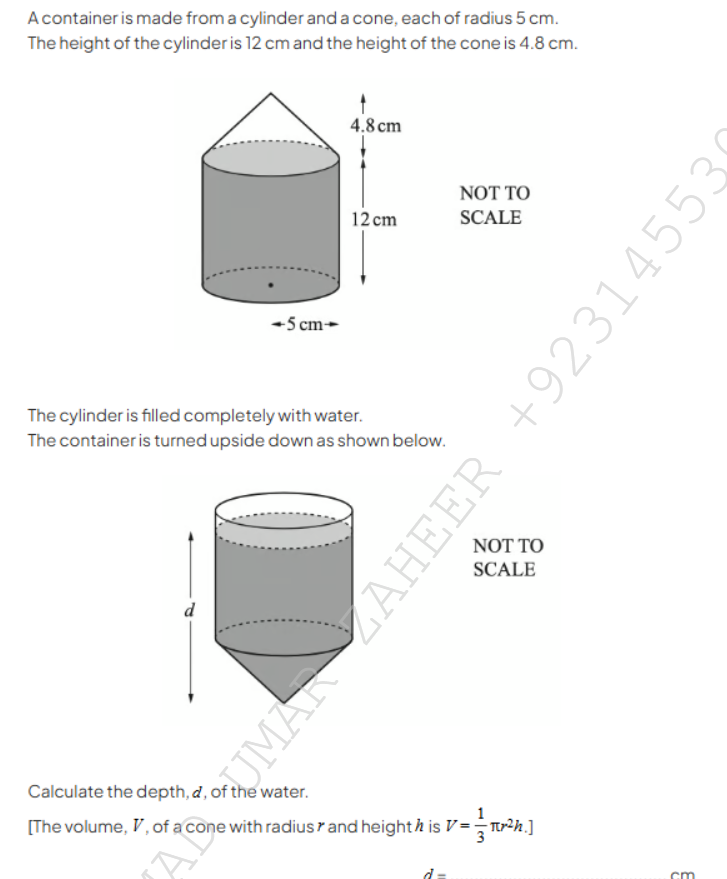A container made from a cylinder and a cone, each radius 5 cm. The height of the cylinder is 12 cm and the height of the cone is 4.8 cm. The cylinder is filled completely with wate... A container made from a cylinder and a cone, each radius 5 cm. The height of the cylinder is 12 cm and the height of the cone is 4.8 cm. The cylinder is filled completely with water. After turning it upside down, calculate the depth, d, of the water. [The volume, V, of a cone with radius r and height h is V = 1/3 πr²h.]

Understand the Problem
The question is asking to calculate the depth of water in a container formed by a cylinder and a cone when the container is turned upside down. The total dimensions of both shapes are provided, and we need to apply the formula for the volume of a cone to find the depth of water, d.
Answer
The depth $d$ of the water is approximately $9.44$ cm.
Answer for screen readers
The depth $d$ of the water is approximately $9.44$ cm.
Steps to Solve
- Calculate the total volume of water in the cylinder
The volume $V_c$ of the cylinder can be calculated using the formula:
$$ V_c = \pi r^2 h $$
Here, the radius $r = 5$ cm and the height $h = 12$ cm.
Substituting the values, we get:
$$ V_c = \pi (5)^2 (12) = 300\pi \text{ cm}^3 $$
- Determine the volume of the cone
The volume $V_{cone}$ of the cone can be calculated using the formula:
$$ V_{cone} = \frac{1}{3} \pi r^2 h $$
For the cone, the radius $r = 5$ cm and the height $h = 4.8$ cm.
Substituting the values, we find:
$$ V_{cone} = \frac{1}{3} \pi (5)^2 (4.8) = 40 \pi \text{ cm}^3 $$
- Set the volume of water equal to the volume of the cone
When the container is turned upside down, the water will fill the cone section. The depth $d$ of the water in the cone can be calculated by finding the relation between the volume of the water and the volume of the cone at that depth.
We can express the volume of water in the cone created by the water at depth $d$:
$$ V_{water} = \frac{1}{3} \pi r^2 d $$
Where $r$ is the radius at depth $d$. Considering the similar triangles, we can express the radius $r$ in terms of $d$:
$$ \frac{r}{d} = \frac{5}{4.8} \implies r = \frac{5}{4.8}d $$
Substituting this in the volume of water:
$$ V_{water} = \frac{1}{3} \pi \left(\frac{5}{4.8} d\right)^2 d $$
- Equate the volumes
Setting the volume of water equal to the volume of the original cylindrical water:
$$ 300\pi = \frac{1}{3} \pi \left(\frac{5^2}{4.8^2}\right) d^3 $$
- Simplify and solve for $d$
Cancel $\pi$ from both sides:
$$ 300 = \frac{1}{3} \left(\frac{25}{23.04}\right) d^3 $$
Multiply through by 3:
$$ 900 = \frac{25}{23.04} d^3 $$
Multiply through by $23.04$:
$$ 900 \times 23.04 = 25d^3 $$
Now divide by 25:
$$ d^3 = \frac{20736}{25} $$
Take the cube root of both sides:
$$ d = \sqrt[3]{829.44} $$
Calculating gives:
$$ d \approx 9.44 \text{ cm} $$
The depth $d$ of the water is approximately $9.44$ cm.
More Information
The volume of water initially in the cylindrical part of the container determines the depth when the container is inverted. The use of similar triangles allows us to relate the height of water in the cone to its volume.
Tips
- Confusing the radius and height when applying the formulas.
- Forgetting to use the correct proportional relationship from similar triangles when calculating the radius at depth $d$.
- Not properly simplifying the equations before solving for $d$.
AI-generated content may contain errors. Please verify critical information